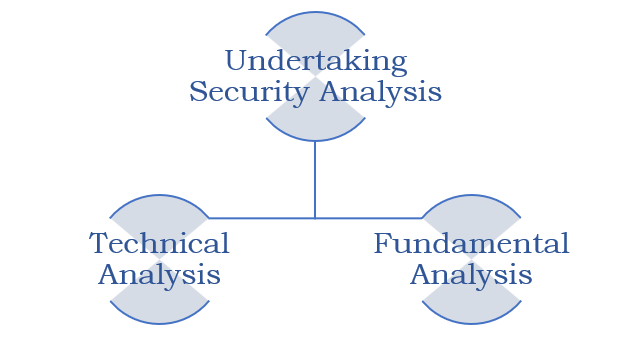Security Analysis Of Stocks
Om Prakash Jha | Updated: 28 February, 2022
Security Analysis of stocks means, analyzing the risk-return profile of security. It includes estimating the value that s company may achieve over some time. It considers both- positive and negative sides that may hit a stock performance.

Technical Analysis
Technical Analysis is meant for Short Term traders, say daily or monthly players. Technical Analysis is based on assumption that ‘History tends to repeat itself.’ Technical Analysts use various Technical Indicators to do analysis, such as RSI, Moving average, Pivot Points, Super-trend, Bollinger Bands, etc.
Fundamental Analysis
- Economic Analysis
- Industry Analysis
- Company Analysis
Economic Analysis
Economic Analysis includes analyzing the Economy as a whole. How the economy is performing, Consumption pattern of population, Inflation rates, and other factors. There is a saying that, “a rising tide lifts all boats”. A Similar saying about the market is that, when an economy grows, all Industries are also benefitted from such growth. Some of the factors are as follows:
- Growth Rates of Income: For this purpose- GDP, GNP data, Per capita income are considered. Commentary by World Bank, IMF, RBI, and other Investment Banks are also considered by analysts. This is done to analyze the Average Income and consumption of people for each Industry in the economy.
- Growth Rate of Industrial Sector: This refers to the growth of all Industries which are operating in a country. The difference between this, and Industry analysis is that this covers the growth of all Industries which are operating in the economy as against Industry analysis which includes analysis of specific industries in which the company being analyzed operates in. For this, data of CII, FICCI, and Industry-specific bodies are considered.
- Inflation rates and other factors impacting purchasing power of the economy. For this purpose, data of RBI, RBI Policy, MoF policy, Budget commentary, Federal Policy, Fed Rates, and other similar factors are considered.
- Interest Rates: Interest rates are determined by the Central Bank of a company. In India, the Interest Rate (Bond Yield) of both India and America (Fed Rates). Also, RBI policy and Fed policy are important for Investors.
- Monsoon, and other factors impacting the Production capacity of the economy. In a country like India, where the majority of the population is involved in Farming, which is highly dependent on Monsoon, Monsoon plays a major role in determining the level of Income and hence, consumption pattern of the economy.
- Geo-Political Conditions: This includes Political stability in a country, their political and diplomatic relations with other international governments, the attitude of the government towards Industry. This also includes an analysis of the Government budget, government policies. It includes special emphasis on Government Deficit, Taxation impact, Government expenditure, etc.
- Industrial Infrastructure: Availability & Conditions of Industrial Infra like Transportation. Communication etc. are also components to be considered. The performance of any Industry is based on the infrastructure available for it.
Author’s Comments: Economic analysis for Retail investors is of not much use because they don’t have many options to change the economy they are going to invest in. Even though, these days there are Brokers, which have made it possible to invest globally. Yet, it is out of reach to mainly retail clients. Hence, based on economic analysis, the decision as to whether Investment in Equity is to be made or in Bank FD or other safe modes can be made.
Economic Analysis is mainly helpful for HNI, or other clients to whom access to the International market is available.
Industry Analysis
This involves analyzing the industry in which the company being analyzed operates. When an Industry grows, generally all companies operating in that Industry are benefitted from the same. For Industry analysis commentary of CII, FICCI, Industry-specific bodies, Investment Banks, etc. are considered. Not only this, Phase (in Life cycle analysis) of Industry- Initial, developing or developed, the expected growth of Industry, Changes in Technology, Level of competition, and other factors are considered for this.
Company Analysis
This involves analysis of the target company. Checking past performance, Ranking among Competitors, Financial Ratios, Expertise of promoters, the Production capacity of the company, availability of finance to the company, Brand Value, Values of the company, possibility of expansion, etc.
.gif)

